 W
WAkatoreite ((Mn2+, Fe2+)9Al2[(OH)3|HSi4O13]) is a mineral found in New Zealand.
 W
WÅkermanite (Ca2Mg[Si2O7]) is a melilite mineral of the sorosilicate group, containing calcium, magnesium, silicon, and oxygen. It is a product of contact metamorphism of siliceous limestones and dolomites, and rocks of sanidinite facies. Sanidinite facies represent the highest conditions of temperature of contact metamorphism and are characterized by the absence of hydrous minerals. It has a density of 2.944 g/cm3. Åkermanite ranks a 5 or 6 on the Mohs scale of mineral hardness, and can be found gray, green, brown, or colorless. It has a white streak and a vitreous or resinous luster. It has a tetragonal crystal system and a good, or distinct, cleavage. It is the end member in a solid solution series beginning with gehlenite (Ca2Al[AlSiO2]).
 W
WAxinite is a brown to violet-brown, or reddish-brown bladed group of minerals composed of calcium aluminium boro-silicate, (Ca,Fe,Mn)3Al2BO3Si4O12OH. Axinite is pyroelectric and piezoelectric.
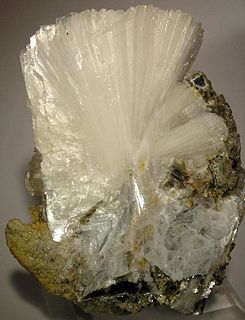 W
WBertrandite is a beryllium sorosilicate hydroxide mineral with composition: Be4Si2O7(OH)2. Bertrandite is a colorless to pale yellow orthorhombic mineral with a hardness of 6-7.
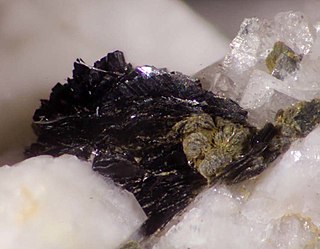 W
WCervandonite is a rare arsenosilicate mineral. It has a chemical formula (Ce,Nd,La)(Fe3+,Fe2+,Ti4+,Al)3SiAs(SiAsO13) or (Ce,Nd,La)(Fe3+,Fe2+,Ti,Al)3O2(Si2O7)(As3+O3)(OH). It has a monoclinic crustal structure with supercell (Z=6), the crystal structure was established as a trigonal subcell, with space group R3m and a = 6.508(1)Ǻ, c = 18.520(3) Ǻ, V 679.4(2) Ǻ3, and Z=3. It was first described by Buhler Armbruster in 1988, but it has proven to be problem due to the extreme scarcity of single crystals and its unusual replacement of silicon and arsenic. Cervandonite is named after the location where it was first described, Pizzo Cervandone (Scherbadung), Italy in the Central Alps.
 W
WClinozoisite is a complex calcium aluminium sorosilicate mineral with formula: Ca2Al3(Si2O7)(SiO4)O(OH). It forms a continuous solid solution series with epidote by substitution of iron(III) in the aluminium (m3 site) and is also called aluminium epidote.
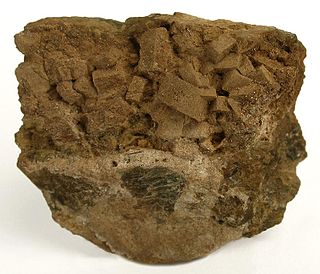 W
WGehlenite, (Ca2Al[AlSiO7]), is a sorosilicate, Al-rich endmember of the melilite complete solid solution series with akermanite. The type locality is in the Monzoni Mountains, Fassa Valley in Trentino in Italy, and is named after Adolf Ferdinand Gehlen (1775–1815) by A.J. Fuchs in 1815.
 W
WHardystonite is a rare calcium zinc silicate mineral first described from the Franklin, New Jersey, U.S. zinc deposits. It often contains lead, which was detrimental to the zinc smelting process, so it was not a useful ore mineral. Like many of the famous Franklin minerals, hardystonite responds to short wave ultraviolet light, emitting a fluorescence from dark purple to bright violet blue. In daylight, it is white to gray to light pink in color, sometimes with a vitreous or greasy luster. It is very rarely found as well formed crystals, and these are usually rectangular in appearance and rock-locked.
 W
WHemimorphite, is Zn4(Si2O7)(OH)2·H2O, a component of calamine. It is a sorosilicate mineral which has been historically mined from the upper parts of zinc and lead ores, chiefly associated with smithsonite, ZnCO3. They were assumed to be the same mineral and both were classed under the same name of calamine. In the second half of the 18th century it was discovered that these two different minerals were both present in calamine. They closely resemble each other.
 W
WThe mineral hubeite, Ca2Mn2+Fe3+[Si4O12(OH)]·(H2O)2, is a sorosilicate of the Si4O13 group. Structurally it also belongs to the Akatoreite group. It was found and named after the province of Hubei, China. It is common to iron ores in a mine of that region. It occurs mainly as aggregates of fan like crystals. It is dark to pale brown, has orange-brown streak and is vitreous. Hubeite has a hardness of 5.5 in the Mohs scale, one good cleavage and conchoidal fracture. It is triclinic with a space group of P1*. The structure of hubeite is very uncommon, and in fact there is only one other mineral that fits the Si4O13 group, which is ruizite.
 W
WIlvaite is a sorosilicate of iron and calcium with formula: CaFe2+2Fe3+Si2O7O(OH). Both manganese and magnesium substitute in the structure. Ilvaite crystallizes in the monoclinic system in black prismatic crystals and columnar masses. It is black to brownish black to gray and opaque. It has a Mohs hardness of 5.5 to 6 and a specific gravity of 3.8 to 4.1. Ilvaite is structurally related to lawsonite.
 W
WJinshajiangite is a rare silicate mineral named after the Jinshajiang river in China. Its currently accepted formula is BaNaFe4Ti2(Si2O7)2O2(OH)2F. It gives a name of the jinshajiangite group. The mineral is associated with alkaline rocks. In jinshajiangite, there is a potassium-to-barium, calcium-to-sodium, manganese-to-iron and iron-to-titanium diadochy substitution. Jinshajiangite is the iron-analogue of surkhobite and perraultite. It is chemically related to bafertisite, cámaraite and emmerichite. Its structure is related to that of bafertisite. Jinshajiangite is a titanosilicate with heteropolyhedral HOH layers, where the H-layer is a mixed tetrahedral-octahedral layer, and the O-layer is simply octahedral.
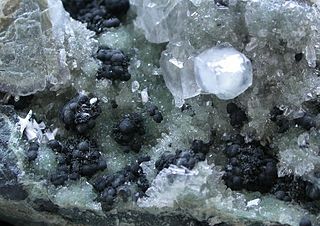 W
WJulgoldite is a member of the pumpellyite mineral series, a series of minerals characterized by the chemical bonding of silica tetrahedra with alkali and transition metal cations. Julgoldites, along with more common minerals like epidote and vesuvianite, belong to the subclass of sorosilicates, the rock-forming minerals that contain SiO4 tetrahedra that share a common oxygen to form Si2O7 ions with a charge of 6- (Deer et al., 1996). Julgoldite has been recognized for its importance in low grade metamorphism, forming under shear stress accompanied by relatively low temperatures (Coombs, 1953). Julgoldite was named in honor of Professor Julian Royce Goldsmith (1918–1999) of the University of Chicago.
 W
WJunitoite is a mineral with formula CaZn2Si2O7·H2O. It was discovered at the Christmas mine in Christmas, Arizona, and described in 1976. The mineral is named for mineral chemist Jun Ito (1926–1978).
 W
WKinoite (Ca2Cu2Si3O8(OH)4 or Ca2Cu2Si3O10·2H2O) is a light blue copper silicate mineral. It is somewhat scarce. It has a monoclinic crystal system, vitreous luster, and is transparent to translucent. It can be found in the Santa Rita Mountains, the Christmas Mine at Christmas, Arizona and a few other copper mines. Kinoite is popular with mineral collectors. Kinoite was named upon its discovery in 1970 after the pioneer Jesuit missionary Padre Eusebio Kino who worked in Arizona, Sonora and Baja California.
 W
WKornerupine (also called Prismatine) is a rare boro-silicate mineral with the formula (Mg,Fe2+)4(Al,Fe3+)6(SiO4,BO4)5(O,OH)2. It crystallizes in the orthorhombic - dipyramidal crystal system as brown, green, yellow to colorless slender tourmaline like prisms or in massive fibrous forms. It has a Mohs hardness of 7 and a specific gravity of 3.3 to 3.34. Its indices of refraction are nα=1.660 - 1.671, nβ=1.673 - 1.683 and nγ=1.674 - 1.684.
 W
WLawsonite is a hydrous calcium aluminium sorosilicate mineral with formula CaAl2Si2O7(OH)2·H2O. Lawsonite crystallizes in the orthorhombic system in prismatic, often tabular crystals. Crystal twinning is common. It forms transparent to translucent colorless, white, and bluish to pinkish grey glassy to greasy crystals. Refractive indices are nα=1.665, nβ=1.672 - 1.676, and nγ=1.684 - 1.686. It is typically almost colorless in thin section, but some lawsonite is pleochroic from colorless to pale yellow to pale blue, depending on orientation. The mineral has a Mohs hardness of 8 and a specific gravity of 3.09. It has perfect cleavage in two directions and a brittle fracture.
 W
WManganvesuvianite is a rare mineral with formula Ca19Mn3+(Al,Mn3+,Fe3+)10(Mg,Mn2+)2(Si2O7)4(SiO4)10O(OH)9. The mineral is red to nearly black in color. Discovered in South Africa and described in 2002, it was so named for the prevalence of manganese in its composition and its relation to vesuvianite.
 W
WMelilite refers to a mineral of the melilite group. Minerals of the group are solid solutions of several endmembers, the most important of which are gehlenite and åkermanite. A generalized formula for common melilite is (Ca,Na)2(Al,Mg,Fe2+)[(Al,Si)SiO7]. Discovered in 1793 near Rome, it has a yellowish, greenish-brown color. The name derives from the Greek words meli (μέλι) "honey" and lithos (λίθους) "stone".
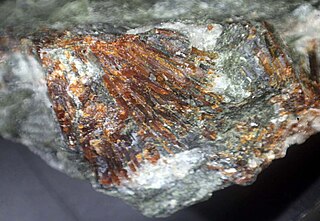 W
WNormandite is a brittle orange brown sorosilicate mineral discovered in 1997 by Charles Normand, of Montreal. Normandite occurs in Khibiny Massif, Kola, Russia; in Poudrette quarry, Mont-Saint-Hilaire, Quebec and Tenerife, Canary Islands. It is found in nepheline syenite and in miarolitic cavities in nepheline syenite, associated with nepheline, albite, microcline, aegirine, natrolite, catapleiite, kupletskite, eudialyte, cancrinite, villiaumite, rinkite, and donnayite-(Y).
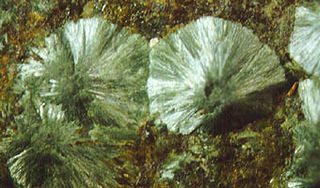 W
WPumpellyite is a group of closely related sorosilicate minerals:pumpellyite-(Mg): Ca2MgAl2[(OH)2|SiO4|Si2O7]·(H2O) pumpellyite-(Fe2+): Ca2Fe2+Al2[(OH)2|SiO4|Si2O7]·(H2O) pumpellyite-(Fe3+): Ca2(Fe3+,Mg,Fe2+)(Al,Fe3+)2[(OH,O)2|SiO4|Si2O7]·H2O pumpellyite-(Mn2+): Ca2(Mn2+,Mg)(Al,Mn3+,Fe3+)2[(OH)2|SiO4|Si2O7]·(H2O) pumpellyite-(Al): Ca2(Al,Fe2+,Mg)Al2[(OH,O)2|SiO4|Si2O7]·H2O
 W
WA pyrosilicate is a type of chemical compound; either an ionic compound that contains the pyrosilicate anion Si2O6−7, or an organic compound with the hexavalent ≡O3Si-O-SiO3≡ group. The anion is also called disilicate or diorthosilicate.
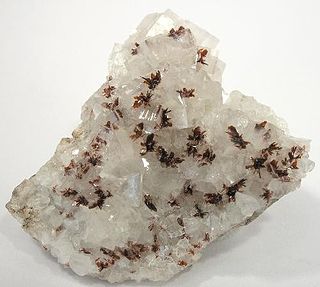 W
WRuizite is a sorosilicate mineral with formula Ca2Mn2Si4O11(OH)4·2H2O. It was discovered at the Christmas mine in Christmas, Arizona, and described in 1977. The mineral is named for discoverer Joe Ana Ruiz.
 W
WSeidozerite is a sorosilicate from the seidozerite supergroup (a "titanium disilicate"). It was first described by Semenov, Kazakova and Simonov in 1958. Its chemical formula is Na4MnZr2Ti(Si2O7)2O2F2 and its type locality is 'Pegmatite No. 58', Lake Seydozero, Lovozero massif, Kola peninsula, Murmansk Oblast.
 W
WSursassite is a sorosilicate mineral. It was first discovered in 1926. It was first found in the Sursass (Oberhalbstein), a district of Graubünden, Switzerland. It is generally found in deposits of metamorphosed manganese.
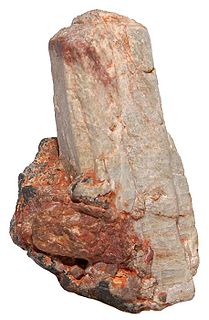 W
WThortveitite is a mineral consisting of scandium yttrium silicate (Sc,Y)2Si2O7. It is the primary source of scandium. Occurrence is in granitic pegmatites. It was named after Olaus Thortveit, a Norwegian engineer. It is grayish-green, black or gray in color.
 W
WThulite (sometimes called rosaline) is a translucent, crystalline or massive pink manganese-bearing variety of the mineral zoisite. Manganese substitutes for calcium in the structure with up to two percent Mn2+. Thulite is often mottled with white calcite and occurs as veins and fracture fillings transecting many types of rock. In mineralogical literature, thulite may sometimes refer to any pink zoisite. Clinothulite is the manganese bearing variety of monoclinic clinozoisite.
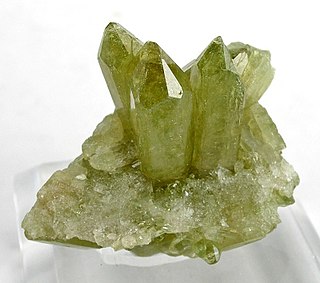 W
WVesuvianite, also known as idocrase, is a green, brown, yellow, or blue silicate mineral. Vesuvianite occurs as tetragonal crystals in skarn deposits and limestones that have been subjected to contact metamorphism. It was first discovered within included blocks or adjacent to lavas on Mount Vesuvius, hence its name. Attractive-looking crystals are sometimes cut as gemstones. Localities which have yielded fine crystallized specimens include Mount Vesuvius and the Ala Valley near Turin, Piedmont.
 W
WWadsleyite, a high-pressure phase of olivine, is an orthorhombic mineral with the formula β-(Mg,Fe)2SiO4. It was first found in nature in the Peace River meteorite from Alberta, Canada. It is formed by a phase transformation from olivine (α-(Mg,Fe)2SiO4) under increasing pressure and eventually transforms into spinel-structured ringwoodite (γ-(Mg,Fe)2SiO4) as pressure increases further. The structure can take up a limited amount of other bivalent cations instead of magnesium, but contrary to the α and γ structures, a β structure with the sum formula Fe2SiO4 is not thermodynamically stable. Its cell parameters are approximately a = 5.7 Å, b = 11.71 Å and c = 8.24 Å.
 W
WWiluite is a dark green, brownish, or black blocky silicate mineral with formula: Ca19(Al,Mg,Fe,Ti)13(B,Al,[ ])5Si18O68(O,OH)10. It has a Mohs hardness of 6 and a specific gravity of 3.36. It has a vitreous lustre, poor cleavage and an irregular brittle fracture. It crystallizes in the tetragonal system and occurs as well-formed crystals with good external form. It is isostructural with the vesuvianite group and is associated with wollastonite and olive-green grossulars (viluites) in a serpentinized skarn.
 W
WYttrialite or Yttrialite-(Y) is a rare yttrium thorium sorosilicate mineral with formula: (Y,Th)2Si2O7. It forms green to orange yellow masses with conchoidal fracture. It crystallizes in the monoclinic-prismatic crystal system. It has a Mohs hardness of 5 to 5.5 and a specific gravity of 4.58. It is highly radioactive due to the thorium content.
 W
WZoisite, first known as saualpite, after its type locality, is a calcium aluminium hydroxy sorosilicate belonging to the epidote group of minerals. Its chemical formula is Ca2Al3(SiO4)(Si2O7)O(OH).
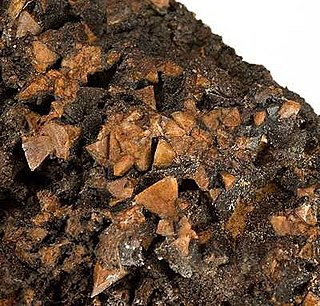 W
WZunyite is a sorosilicate mineral, Al13Si5O20(OH,F)18Cl, composed of aluminium, silicon, hydrogen, chlorine, oxygen, and fluorine.